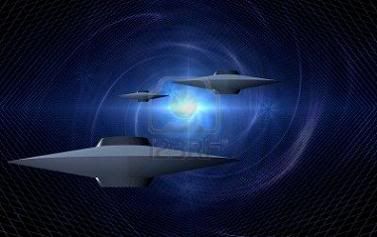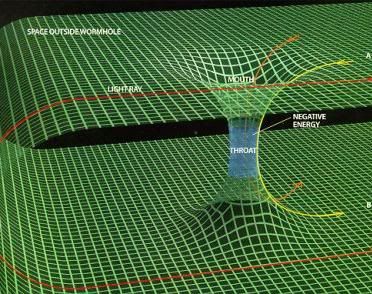Post by glactus on Jul 4, 2011 5:42:50 GMT

Aliens entering a Wormhole - Destination - our Galaxy.
In physics a wormhole is a hypothetical topological feature of spacetime that would be, fundamentally, a "shortcut" through spacetime. For a simple visual explanation of a wormhole, consider spacetime visualized as a two-dimensional (2D) surface. If this surface is folded along a third dimension, it allows one to picture a wormhole "bridge". (Please note, though, that this is merely a visualization displayed to convey an essentially unvisualisable structure existing in 4 or more dimensions.)

Graphics of a Wormhole
The parts of the wormhole could be higher-dimensional analogues for the parts of the curved 2D surface; for example, instead of mouths which are circular holes in a 2D plane, a real wormhole's mouths could be spheres in 3D space.) A wormhole is, in theory, much like a tunnel with two ends each in separate points in spacetime, or it can be also known as two connecting black holes.

A typical Wormhole
There is no observational evidence for wormholes, but on a theoretical level there are valid solutions to the equations of the theory of general relativity which contain wormholes. The first type of wormhole solution discovered was the Schwarzschild wormhole which would be present in the Schwarzschild metric describing an eternal black hole, but it was found that this type of wormhole would collapse too quickly for anything to cross from one end to the other.
Wormholes which could actually be crossed, known as traversable wormholes, would only be possible if exotic matter with negative energy density could be used to stabilize them. (Many physicists such as Stephen Hawking, Kip Thorne, and others believe that the Casimir effect is evidence that negative energy densities are possible in nature.
Physicists have also not found any natural process which would be predicted to form a wormhole naturally in the context of general relativity, although the quantum foam hypothesis is sometimes used to suggest that tiny wormholes might appear and disappear spontaneously at the Planck scale, and stable versions of such wormholes have been suggested as dark matter candidates.
It has also been proposed that if a tiny wormhole held open by a negative-mass cosmic string had appeared around the time of the Big Bang, it could have been inflated to macroscopic size by cosmic inflation..This analysis forces one to consider situations where there is a net flux of lines of force, through what topologists would call "a handle" of the multiply-connected space, and what physicists might perhaps be excused for more vividly terming a "wormhole"
To see Video, click on the URL below. Has sound.
www.youtube.com/watch?v=WHRtdyW9ong
Looking at a Wormhole
Credits: These are non copywrite images.
Text: This is part text only. See full text byJohn Wheeler in Annals of Physics, by way of Wikipedia
en.wikipedia.org/wiki/Wormhole
Telescope in avatar: Meade 16" LX 200
Astronomer in avatar: Glactu



